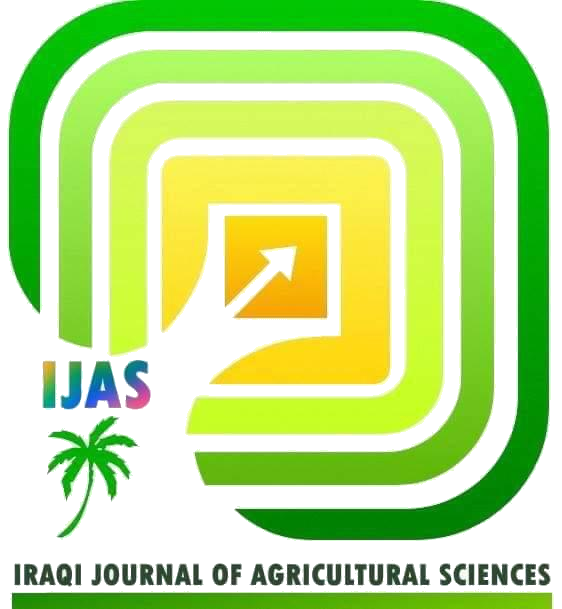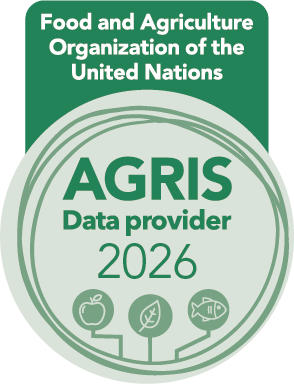PRESENCE AND ABSENCE OF QUANTITATIVE TRAITS LOCI (QTL) REGION ON CHROMOSOME Z AND ITS EFFECT ON SOME PRODUCTIVE AND PHYSIOLOGICAL TRAITS IN LOCAL IRAQI CHICKEN
DOI:
https://doi.org/10.36103/2k5q4778Keywords:
PCR, sexual maturity, serum traits, egg weight, egg shellAbstract
This study was carried out to identify the effect of the quantitative trait loci (QTL) region on some productive and physiological traits of Iraqi chickens. One hundred five and ten-week-old laying hens were used and bred in individual sages from sexual maturity to 100 days of production. Blood samples were collected from the brachial vein for DNA extraction and serum isolation, and then polymerase chain reaction (PCR) was done to determine the target region of the QTL. Two groups were obtained: the first had a PCR product with band 294 bp denoted (P) and the second had no PCR product denoted (NP). The P group had a significant (p < 0.05) effect on egg weight at the second stage of the study amounted 48.23 gm. and a significant (p < 0.05) effect was observed in egg shell weight amounted 6.97 gm. No significant effects were found in all productive, physiological, or qualitative traits.In conclusion, the presence and absence of QTL regions significantly affect egg weight and egg shell weight, which is suitable for selection programs to improve the genetic makeup of Iraqi chicken.
References
1. Al Ani, M.A.K. and B.G.M. Al khatib 2025. Leptin receptor gene polymorphisms and its effect on some productive and physiological traits in local Iraqi chicken. Iraqi Journal of Agricultural Sciences. 56 (2): 736-743. https://doi.org/10.36103/kb89xk27 .
2. Ahsan, M., X. Li, A.E. Lundberg,M. Kierczak, P.B.Siegel, Ö. Carlborg , and S. Marklund. 2013. Identification of candidate genes and mutations in QTL regions for chicken growth using bioinformatics analysis of NGS and SNP-chip data. Front. Genet. 4.1-8. https://doi.org/10.3389/fgene.2013.00226.
3. AL-Hassani, D.H and M.S. AL-Jebouri. 1988. Heat tolerance of Iraqi chicken. pp686-688. In Proc.XVIII World Poultry Congress. Nagoya, Japan.
4. Al-Khatib B.G.M., A.A. Noori and Q.I. Abdul Kareem, 2018. Association of G143831A SNP of growth hormone gene and some productive traits, physiological parameters of laying hens. Res. J. Pharm. Biol. Chem. Sci.9(5): 822-828.
5. Ameen Q. A., M. A., Rana A. A., Sadat A. Sehand M. A. Mahdi S. S. Ahmed N. H., Hani A. Basil and H. Adel 2022. Polymorphisms Of the QTL Region Associated with Shank Feathering in Chicken. Bas. J. Vet. Res., 21(1):154-161. https://doi.org/10.23975/bjvetr.2022.177434 .
6. Arthur, J. A. and G.A.A. Albers. 2003. Industrial persprctive on problems and issues associated with poultry breeding. In:Poultry Breeding, Genetic and Biotechnology, W. M. Muir and S. E. Aggrey (eds.), pp.1-12.
7. Asadollahi, H.; R.; Vaez Torshizi, A.; Ehsani, A.A. Masoudi, 2022. An Association of CEP78, MEF2C, VPS13A and ARRDC3 Genes with Survivability to Heat Stress in an F2 Chicken Population. J. Anim. Breed. Genet. 139, 574–582. https://doi.org/10.1111/jbg.12675 .
8. Eidan, S. M., and S. A. Khudhir, 2023. Association between ATP1A1 gene polymorphisms with semen characteristics in Holstein bulls. Iraqi Journal of Agricultural Sciences.54(2),330.337.
https://doi.org/10.36103/ijas.v54i2.1706.
9. Eitan, Y., and M. Soller .2001. Effect of photoperiod and quantitative feed restriction in a broiler strain on onset of lay in females and onset of semen production in males: a genetic hypothesis. Poult. Sci. 80: 1397–1405. https://doi.org/10.1093/ps/80.10.1397.
10. Frisch, R.E. 1994. The right weight: body fat, menarche and fertility. Proceedings of the Nutrition Society., 53: 113–129. https://doi.org/10.1079/PNS19940015.
11. Godoy T. F., Moreira G. C. M., Boschiero C., Gheyas A. A., Gasparin G., Paduan M., Andrade S. C. S., Montenegro H., Burt D. W., Ledur M. C. and Coutinho L. L.2015. SNP and INDEL detection in a QTL region on chicken chromosome 2 associated with muscle deposition. Anim. Gen.46 (2)158-163. https://doi.org/10.1111/age.12271 .
12. Goto, N., M. Nishibori, T. Umino and M. Tsudzuki.2014. Mapping of main-effect and epistatic Quantitative trait loci for internal egg traits in an F2 resource population of chickens. J. Poult. Sci. 51: 375.386.
https://doi.org/10.2141/jpsa.0140030.
13. Goto, T., and M. Tsudzuki. 2017. Genetic Mapping of Quantitative Trait Loci for Egg Production and Egg Quality Traits in Chickens: a Review. J. Poult. Sci.., 54. 1-12. https://doi.org/10.2141/jpsa.016012.
14. Guo, X.; Xing, C.-H.;Wei,W.; Zhang, X.-F.;Wei, Z.-Y.; Ren, L.-L.; Jiang, J.-J.; Li, M.;Wang, J.-X.; He, X.-X. 2022. Genome-Wide Scan for Selection Signatures and Genes Related to Heat Tolerance in Domestic Chickens in the Tropical and Temperate Regions in Asia. Poult. Sci., 101, 101821. https://doi.org/10.1016/j.animal.2024.101151 .
15. Hajibarat Z., A., Saidi M., Zeinalabedini M. Mardi and M. R. Ghaffari 2024. Integrating Quantitative Trait Loci (QTLs) through Meta-QTL (MQTL) Analysis to Facilitate Identification of Relationships between Phenotype and Genotype. Biol. Bull Russ. Acad. Sci., 51, 1761 -1776.
https://doi.org/10.1134/S1062359024606888 .
16. Hajibarat, Z., Saidi, A., M., Zeinalabedini, M. Mardi, and M.R., Ghaffari, 2024. Determining the Relationships Between Genotype and Phenotype Using Molecular Genetic Tools in Chickens. Jentashapir J. Cell. Mol. Biol., 15(1), e144329. https://doi.org/10.5812/jjcmb-144329 .
17. Hu, Z. L., C. A. Park, and J. M. Reecy. 2016. Developmental progress and current status of the Animal QTLdb. Nucleic Acids Res. 44(D1): D827–D833. https://doi.org/10.1093/nar/gkv1233.
18. Li Y, X, Liu X, Bai Y, Wang L, Leng H, Li Y, Zhang Z, Cao P, Luan and F. Xiao 2022. Genetic parameters estimation and genome-wide association studies for internal organ traits in an F(2) chicken population. J. Anim. Breed. Genet. 139(4):434–46. https://doi.org/10.1016/j.psj.2022.101821.
19. .Li, W., Z., Maiqing Z., Guiping W., Jie L., Jie W., Shunli F., Furong L., Dawei Z., Dan L., Qinghe G., Liping G., Yuming L. Ranran and W. Jie 2021. Identification of QTL regions and candidate genes for growth and feed efficiency in broilers. Genet Sel. Evol., 53:13.
https://doi.org/10.1186/s12711-021-00608-3 .
20. Lien C., Michèle T. B., Shih-Wen W. and Chih-Feng C. 2020. Identification of QTL and loci for egg production traits to tropical climate conditions in chickens. Livest. Sci., 234, 103980. https://doi.org/10.1016/j.livsci.2020.103980 .
21. Liu,W., D.Li, J.Liu,S.Chen, L.Qu, J.Zheng, G.Xu and N.Yang.2011.A Genome-wide SNP scan reveals novel loci for egg production and quality traits in white leghorn and brown–egg dwarf layers. PLOS.One, 6(12),1-8. https://doi.org/10.1371/journal.pone.0029290.
22. Lu, Q., W. Jialei, and Z. Hongfu. 2007. Effect of chronic heat Eexposure on fat deposition and meat quality in two genetic types of chicken. Poult. Sci., 86: 1059-1064. https://doi.org/10.1093/ps/86.6.1059.
23. Muhammad,Abd al-llah Hamid,Abd al-Muttalib Karim al-Athari,Abd al-Razzaq Abd al-Hamid al-Rawi and kamel Haif Shadid 1999. Devising hybrids from chickens for rural and home breeding. Arab Organ. Local Agric. Dev. J., 105 (1):94.
24. Noori A. Alan, Abdul kareem Q. Ibtisam and Al khatib B. G. M. 2019. Fifth exon and partial of exon six polymorphisms of growth hormone receptor (GHR) gene and its association with some productive and physiological traits of laying hens. Biochem. Cell. Arch. 19 (1): 1291-1296. https://doi.org/10.35124/bca.2019.19.1.1291.
25. Ruy, D., N. Katia, B. Erica, L.Monica, M. Claudio, A. Marcel, C. Raquel, and C. Luiz. 2005. Strategic marker selection to detect quantitative trait loci in chicken. Sci. Agric. 62.
https://doi.org/10.1590/S0103-90162005000200003 .
26. Sandrine M., R., Nicole G., Irène C., Céline B., Marie Yvonne S., Nadine C., Marie L. Elisabeth and N. Agnès 2015. Detection of QTL controlling feed efficiency and excretion in chickens fed a wheat based diet. Genet. Sel. Evol., 47, 74.
https://doi.org/10.1186/s12711-015-0156-y .
27. SAS. 2012. Statistical Analysis System, User's Guide. Statistical. Version 9.1th ed. SAS. Institute Incorporated Cary. N.C. USA.
28.Shijie L., Danny A., MostafaK. N., Annett W., Steffen W., Eryao W. and Gudrun A. B. 2023. High-density genotyping reveals candidate genomic regions for chicken body size in breeds of Asian origin. Poult. Sci.,102:102303 https://doi.org/10.1016/j.psj.2022.102303 .
29. Wang, J., J., Liu, and Q. Lei, 2024. Elucidation of the genetic determination of body weight and size in Chinese local chicken breeds by large-scale genomic analyses. BMC Genom., 25, 296. https://doi.org/10.1186/s12864-024-10185-6 .
30. Wang ,Y., Perot S., Ganrea C., Rodrigo A.G., Anna W., Janet E. F., Jack M. D., Susan J. L. Terra R. K. and Huaijun Z. 2024. Genomic regions and candidate genes affecting response to heat stress with new castle virus infection in commercial layer chicks using chicken 600k single nucleotide polymorphism array. Int. J. Mol. Sci. 25(5), 2640.
https://doi.org/10.3390/ijms25052640 .
31. Wenya L., J., Zhenzhu C., Yingying W., Xiangnan L., Donghua H., Ruili L., Wenting L. , Guoxi S., Guirong T., Yadong L., Xiaojun K. Xiangtao and L. Zhuanjian 2020. Analysis of four complete linkage sequence variants within a novel lncRNA located in a growth QTL on chromosome 1 related to growth traits in chickens. J. Anim. Sci., 98, (5): skaa122, https://doi.org/10.1093/jas/skaa122.
32. Xu, H., H. Zeng, C. Luo, D. Zhang, Q. Wang, L. Sun, L. Yang, M. Zhou, Q. Nie, and X. Zhang. 2011. Genetic effects of polymorphisms in candidate genes and the QTL region on chicken age at first egg. BMC Genet.12(1)33
http://doi.org/10.1186/1471-2156-12-33.
33. Yannakopoulos, A.L., E. Christaki, and P. Florou-Paneri. 1995. Effect of age and carcass composition on the onset of sexual maturity in quail under normal feeding regimens. Br. Poult. Sci.36: 771–777. https://doi.org/10.1080/00071669508417821.
34. Zamil, D.M. and B. G. M. Al Khatib, 2020. Effect of mutation (C33379782T) in quantitative traits loci (QTL) in local Iraqi chickens on productive and physiological performance. Plant Arch. 20 (1), 489-494.
Downloads
Published
Issue
Section
License
Copyright (c) 2025 IRAQI JOURNAL OF AGRICULTURAL SCIENCES

This work is licensed under a Creative Commons Attribution-NonCommercial 4.0 International License.

2.jpg)


